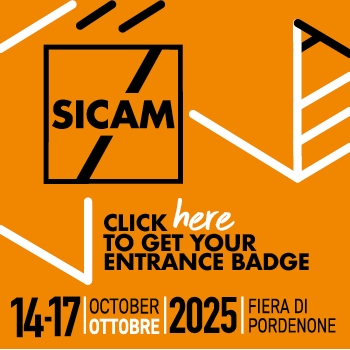Artius is a technology-driven wood-engineering company based in Gurgaon, manufacturing high-end solid wood doors, windows, and door/window frames. It has been successfully catering to the discerning HNI client base across India over the past 10 years of its establishment. Moreover, it focuses on the sustainability of woods in living. In a recent interaction, buildingandinteriors.com spoke to Bhawna Sharma, Managing Director, Artius Interior Products Pvt Ltd, and Pranesh Chhibber, Country Director, FII India to get some information about this partnership.
In this thoughtful take, both Pranesh Chhibber and Bhawna Sharma talk about how Canadian Wood’s collaboration with Artius Interior Products has helped the latter follow sustainable practices and find new possibilities in woodworking and furniture manufacturing.

B&I: Tell us about your company. When and how did you start and what made you enter this industry with a focus on sustainability in living?
Bhawna Sharma: Artius Interior Products has a very interesting history leading to its formation. Necessity being the mother of all inventions, Artius was born out of a personal desire of mine and my husband’s to have modern door and window systems made using natural material (solid wood) for our home that was engineered well enough to shut out Water, Dust, Noise and Insects, etc.
After hunting high and low, we realized these were simply not available in the market and the opportunity was untapped.
The only available option to consumers was the freelance carpenters who not only lacked the technical skills and expertise but also the infrastructure and modern types of machinery and tools required to make a good product, leaving aside a world-class product, which we are looking for.
Thus, we recognized the opportunity and decided to set up a manufacturing unit for the same. The journey since then has been immensely satisfying for us at Artius, as we have been catering to a like-minded client base from amongst HNIs who appreciate natural materials in modern applications that provide sustainability in living.
We thus started making well-engineered door and window systems with a factory on the outskirts of Gurgaon in 2011.

As responsible corporate citizens, we soon recognized the need to ensure that the wood we used should not only be legally harvested but be sourced from sustainably managed forests that were certified by internationally recognized agencies.
While looking for such a reliable source, we met the FII-India (Canadian wood) team at a trade fair, who introduced us to yellow cedar from B.C. Canada – one of the most durable wood species in the world that was naturally resistant to insects, decay, and natural elements.
After due trials, we found yellow cedar to be the ideal species for our solid wood door and window systems as it offered the additional advantage of being available in lumber form (ready-sawn timber) that came duly graded, sized, and seasoned.
This helped us focus our energies on manufacturing a well-engineered product and not worry about material reliability.
B&I: What is your business model, what product categories do you cover, and the market segment do you target and cater to?
Bhawna Sharma: Our business model is offering world-class products through experiential marketing to our HNI clients.
We have a showroom cum experience centre in Gurgaon and a recent one in Hyderabad. Artius’ current product line consists of 14 variants of highly sophisticated Glulam door and window systems and Glulam beams and columns used in structural applications.

Our clients range from industrialists, eminent professionals, celebrities, etc. amongst others. We have furnished their premium residencies, country homes, farms, and beach houses.
In the door and window segment, Artius has also successfully executed many institutional and commercial projects.
B&I: What are the various wood species that Artius uses in its product line to promote sustainability in living?
Bhawna Sharma: We use several species of wood, best suited to the application and budget of our clients. Of these Douglas-fir and yellow cedar from B.C. Canada remains extensively used for a range of applications.
Also, we use Alaskan Cedar and American White Oak a lot. The reasons remain primarily aesthetics, resistance against termites, and their suitability to Indian weather conditions.
As mentioned earlier yellow cedar is one of the world’s most durable species. It contains exceptional longevity given its natural decay resistance and suitability for carvings.
We make its use extensively for doors and windows systems – our core business line. On the other hand, Douglas-fir remains exceptionally well suited for making Glulam posts and beams.
B&I: How important is consistently sized, graded, and duly seasoned lumber to you?
Bhawna Sharma: It is very important as this is the primary factor in terms of quality control and optimizing production time, thus being able to pass on the benefits to our customers.
As HNIs, our clients expect nothing but high-class, global quality levels from us. The wood species (raw material) chosen by us are thus critical in meeting their expectations coupled with our state-of-the-art manufacturing processes and facility thus delivering world-class products.
B&I: How well has your initiative been received on building with wood with support from Canadian Wood at exhibitions like AceTech & IndiaWood?
Bhawna Sharma: Our display clubhouse made using multiple Canadian Wood species remained a showstopper at three premium trade fairs over a period of 6-8 months. The response, large footfalls, and inquiries delighted us.
To capitalize on this response, Artius Interior Products followed up by organizing a 7-day educational trip. It consisted of 16 leading Indian architects from India to Canada with support from FII. They received an introduction to “building with wood” in Canada with support from FII.
This study tour showcased the opportunities and possibilities of engineered wood and mass timber (CLT & GLULAM) to the delegation by showing them iconic wooden structures such as the 18 storey “Brock Commons” students’ hostel building in the UBC Campus, and “Richmond Olympic Oval”, a model for cutting-edge sustainable design, breaking new ground for sports and wellness facilities. The response was in favour of sustainable construction in living using wood Vs construction with bricks and mortar.
Additional impact
The architect’s delegation received the opportunity to interact with celebrated Canadian architects on various topics such as sustainability as well as innovation.
This included a presentation from Michael Green (MGA) and a tour with Don Gurney who personally took time off to take the delegates through “High Point” – a celebrated residence of a millionaire in Whistler (BC) designed by him. Interaction on structural engineering remained another highlight of the tour with Robert Malczyk, celebrated Co-founder of Equilibrium.
FII also arranged to show the architect’s delegation around many other notable installations using mass timber. Major installations remain the convention centre and many other resorts, clubs, and restaurants besides other premium residences. The delegates also got a tour of FP Innovations, a research organization on the UBC campus.
Here the scientists shared highlights of their research on fire, earthquakes, acoustics, etc. with respect to timber buildings.
B&I: Can you elaborate on the species used by Artius in building the Club House with sustainability in mind?
Bhawna Sharma: Douglas-fir remains used for making structural glulam components. It remains highly suitable for this application because of its excellent strength-to-weight ratio. Wall framings used SPF (spruce-pine-fir) given its high dimensional stability. This remains a major reason for its global preference for making wooden houses, interior fit-outs, etc. along with sustainability.
In addition, species such as western red cedar (decking and cladding), western hemlock (panelling and ceiling), and yellow cedar (doors, windows & door/window frames) also remain in use. Canadian Wood provided the necessary material support and technical assistance from initiation to the final execution of the project.
B&I: Can you highlight any following success or outcome as a result of the Club House made with Canadian Wood?

Bhawna Sharma: Every pioneering effort has a long incubation period requiring patience and tenacity. However, we received tremendous responses from the target audience coupled with support from Canadian Wood. It encourages us to continue investing time, effort, and resources in this cause.
The rising interest in structural applications of wood by the architects/designers and the target audience. also emboldens us to continue with our efforts.
We can see visible results as well. e continue to receive multiple inquiries from HNIs and Hospitality sectors which bode well for the future.
B&I: Architects and Design Consultants are a vital link in any building/interior project. As a solution provider to this audience, what is your pitch to them?
Bhawna Sharma: Artius engages with and works closely with architects on an ongoing basis. Environment, sustainability in living, and the sheer elegance of wood are our most powerful pitches.
We see ourselves as project partners of architects rather than as a vendor, manufacturer, or supplier.
B&I: How do you see the market evolve about its choice of solid wood as a raw material? Also, how much a customer is concerned about legally harvested, certified wood from forests that promotes sustainability?
Bhawna Sharma: The trend encourages applications involving solid wood in various segments primarily residential, and hospitality sectors. Such as panelling, cladding, furniture (indoor and outdoor), joinery (doors and windows), pergolas or gazebos, decking, etc. among others.
Customers receive awareness about global warming and carbon footprint. Thus, they have become more conscious about their role in conserving the environment and are consciously asking for products made with legally harvested and certified wood.
Therefore, they move towards sustainability in living with great enthusiasm.
Moreover, leading brands, architects and designers play a major role in educating the end-users.
Additionally, organisations like FII remain committed to the cause of sustainability in living and consistently do their bit with them. They remain increasingly conscious and particular about LEED points in their projects.
B&I: What is your typical project/enquiry flow chart? What are the lead times?
Bhawna Sharma: We follow a consultative approach and offer the right solution to our clients basis their lifestyle and requirements. A project typically takes about 60-90 days to mature from the initial enquiry stage to sales closure.
We have our in-house sales team to reach out to HNIs and the principal architects working on premium residences. They invite them to visit our experience centre.
Moreover, they also engage in value-building sessions to suggest the right solution and then submit the commercials for closure.
B&I: How about customer support in your businesses – what kind of warranties and after-sales service does Artius provide to customers?
Bhawna Sharma: We have a very robust after-sales service. We give a lifetime guarantee on jamming and a ten-year guarantee on seals, hardware, termites, etc.
Our customer support is within 24 hours and it is extremely critical for us to keep our clients extremely happy. Our service levels are very high and unmatched.
That is how Artius keeps building its brand credibility and carving out a niche of providing sustainability in living to its target audience.
Brand Perspective – Pranesh Chhibber, Country Director, FII India

Canadian Wood’s association with Artius
Artius and FII have had a longstanding association for over a decade, during which Artius Interior Products evolved from a high-quality wooden fenestration company specialising in doors and windows to a trailblazer in mass timber construction. The company’s commitment to sustainable materials promoting environmentally friendly living, led by Bhawna Sharma, has allowed it to expand into groundbreaking residential projects, working with leading architects for high-profile clients. Their state-of-the-art plant and machinery ensure top-tier production quality, and their dedication to delivering detailed, architecturally sophisticated projects has solidified their position as industry leaders in working with Canadian wood species in India.
Bhawna Sharma can be reached via email at bhawna@artius.in
Western Hemlock Species by Canadian Wood: Uses and characteristics
British Columbia, Canada, is renowned for its vast forests, teeming with diverse species of trees. Among these, the Western H


























